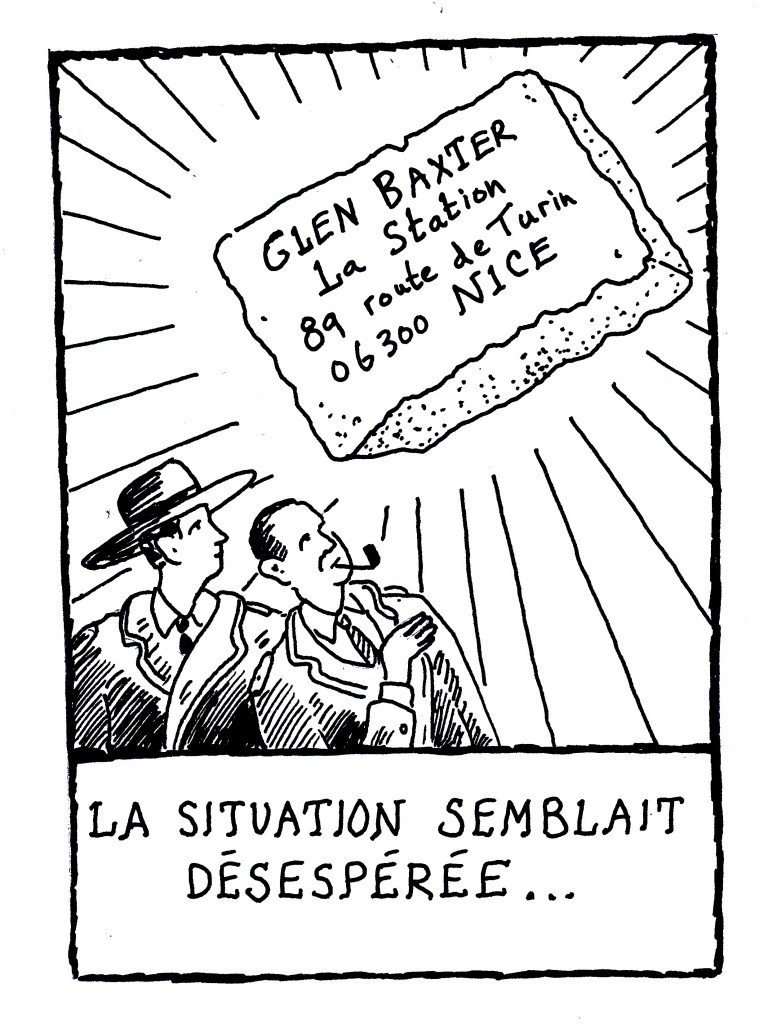
La Station - Nice - France
From 06-29-2013 to 05-10-2013
Download the press release
Opening informations : on Friday June 28, from 6 P.M
The Situation Seemed Desperate…
For its summer exhibition, La Station has the pleasure to have the British artist Glen Baxter. For the occasion, he will move into the totality of La Station’s exhibition space (that is to say, 350 square meters) in particular with a large mural drawing made in situ. He will also offer a limited edition, especially conceived for his coming to Nice.
In the 70s, Glen Baxter invented a formula of drawings with a caption he will later on turn into his usual form of expression: « I found my own way, » he says, « by diverting illustrations of books for teenagers of the 30’s… » Playing with the associations between texts and images, he adorns his old fashioned drawings with delirious comments to get some hilarious shifting effects. The fixed attitude of the characters, a lack of shadows and of expressions, a strictly defined background, his drawings are constructed with a harsh rigour and evacuate any stylistic pathos.
Explorers with colonial hats, students wearing blazers, tea drinkers and cricket players, cowboys and other boy scouts are Glen Baxter’s ordinary heroes. Coming from popular youth tales of the 30s and the 40s, these characters are placed in absurd and extravagant situations, through which they remain impassive. « If the gap between what can be seen and what can be told triggers hilarity, it is sometimes the joint incongruity of text and image that gives rise to laughter. Thus, in a major confusion of times, two cowboys holding their colts and lassos seem to discourse on artworks related to Mondrian, which the legend confirms in the direct style: « C’est soit un faux Mondrian des débuts soit un authentique Burberry tardif » (‘It’s either a forged early Mondrian or an authentic late Burberry.’ ) The burlesque of the situation depicted here is answered by the grotesque of a commentary expressed in the most serious way in the world. The same applies to these three cowboys who, riding their horses, look at the horizon on figures evoking those of Giacometti: « Des Giacometti à perte de vue Shérif !» (‘Giacomettis as far as the eye can see Sheriff!’) Neither illustrated aphorisms, nor simple drawings with a legend, Glen Baxter’s works simultaneously play on the disjunction and interdependence of images and sugary texts to provoke laughter.1″
This master of the incongruous perfectly knows where to put the detail the eye discovers with a delay and that changes the whole meaning of the scene. « One only needs an arrow, a bonnet, a fire in the background so suddenly normality turns into absurdity. ‘The surrealists used to call it the ‘frisson’, this sudden impression that the ground opens up, that we went too fast, that we were mistaken. (…) It’s a fleeting but very strong sensation, as if the mind momentarily lost balance. Exactly what I’m trying to have those looking at my drawings feel. I’ve always loved these hitches in reality, these slight dizzy spells.’ 2″
In his interviews, Glen Baxter readily quotes his sources: Lewis Carroll, the novel What a Life!, considered by Raymond Queneau as the pioneer of Surrealism, Buffalo Bill, Tom Mix, George Herriman (the creator of Krazy Kat), and those he admires most: Jarry, Queneau, Raymond Roussel, Beckett, Magritte, Chirico, Desnos, Man Ray, etc. ‘My ultimate model for sentences is Raymond Roussel. He used a very journalistic style, very flat describing absolutely fantastic events.‘
« It is after having discovered Surrealism and Dadaism (…) that the young Baxter developed, relieved, his appetite for non-sense, the incongruous, irony. Until then, ‘Mr Imperfect’, like his father used to call him, felt slightly mad, out of phase at least. All the more so because, having stammered for a long time, (‘I started by seeing and imagining the words, for want of being able to pronounce them.’), he created an intense connection between language and its sounds.3″
1 Sarah Ihler-Meyer, artpress.com, 2012-2013 (translated from the french version)
2 Stéphane Jarno, « Les dadas du Colonel« , Télérama n° 3077, 2009
3 Marianne Payot, « Glen Baxter, colonel de l’absurde« , L’Express, 2009
Glen Baxter was born in Leeds in 1944, where he attended the College of Art. A painter and a cartoonist, it is mainly his graphic art that made him famous in the United States first, then in Great Britain, in Holland, in Scandinavia, in Australia and Japan, and of course, in France where he regularly exhibits. The one who nicknamed himself « The Colonel » can count among his admirer Prince Charles himself, Monty Pythons’ John Cleese, Salman Rushdie and Tonino Benaquista.
MORE INFORMATION ABOUT GLEN BAXTER :
his website :
www.glenbaxter.com
his tumblr :
http://glenbaxter.tumblr.com
his French gallery’s website :
http://www.lachatregalerie.com
his English gallery’s website :
http://www.flowersgallery.com
Special thanks to Martine and Thibault de la Châtre, Patrick Michaud, Balleor Editions, Anne-Sophie Lecharme, Odile Payen and Hôtel Windsor































